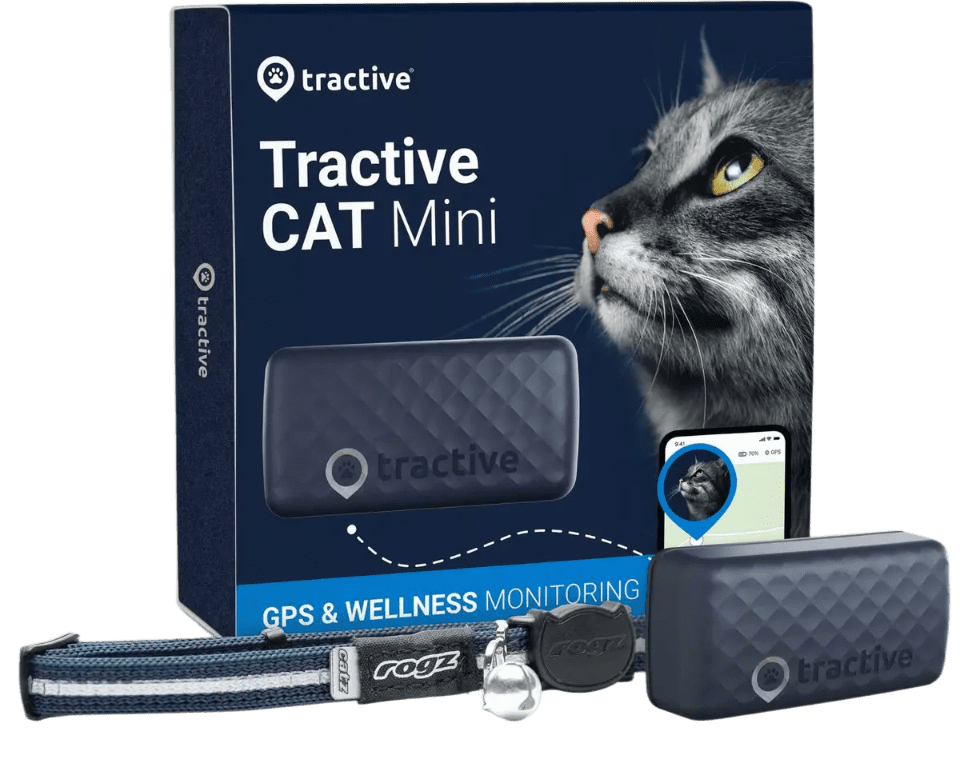A cat tracker is a small device attached to your pet’s collar that uses GPS or cellular networks to show real-time location. It helps find lost cats quickly, reducing stress for owners. Modern trackers combine safety features with a lightweight design for feline comfort. Every year, millions of cats go missing, and time is critical.
This guide cuts through the noise to show you exactly how cat trackers work, which features matter most, and the top vet-approved options to keep your adventurous feline safe and bring them home faster.
Why Cat Trackers Beat Traditional Methods (Microchips Aren’t Enough)
Microchips are vital for permanent ID but have a major limitation: they only work after a lost cat is found and scanned by a shelter or vet.
A cat tracker actively prevents prolonged disappearances by giving you real-time location data.
Cornell University’s 2023 study found 15% of cats experience at least one disappearance, with outdoor-access cats at the highest risk.
Waiting for someone to find and scan your cat wastes precious hours when they could be injured, trapped, or scared.
Here’s why proactive tracking is essential:
- Speed Saves Lives: Locating your cat within the first 24 hours dramatically increases recovery chances. Trackers provide immediate location data, bypassing the “wait and hope” phase.
- Prevents Escalation: Spotting your cat wandering near a busy road? A geofence alert lets you intervene before disaster strikes.
- Reduces Stress: Knowing your cat’s location alleviates the panic of not knowing if they’re safe, hurt, or miles away. This clarity is invaluable for anxious owners.
- Complements Microchips: Use both! The tracker gets them found now; the microchip ensures a permanent ID if the tracker is lost or removed.
Relying solely on collars with bells or breakaways addresses escape, but doesn’t tell you where your cat is once they’re gone. A dedicated cat tracker transforms you from a worried owner into an active guardian.

How Cat Trackers Actually Work
Understanding the technology behind your cat tracker is key to choosing the right one.
Different systems offer varying levels of accuracy, range, and cost. Let’s demystify the main types:
GPS + Cellular Trackers: Precision for Wide-Ranging Cats
These are the most common for true outdoor cats. They combine satellite GPS for location and cellular networks (like your phone) to send that data to your smartphone app.
- How it Works: The tracker connects to GPS satellites to pinpoint location. It then uses a cellular signal (requiring a SIM card and data plan) to transmit this location to the cloud, where your app accesses it in real-time.
- Best For: Cats who roam beyond your immediate neighborhood, explore parks, or live in suburban/rural areas. Offers the widest coverage (nationwide or global, depending on plan).
- Key Considerations:
- Requires Subscription: Monthly or annual cellular data fees are standard ($5-$15/month).
- Battery Life: Typically 2-7 days due to constant satellite/cellular communication. Look for models with replaceable batteries or fast charging.
- Accuracy: Generally very good (10-50 ft), but can be less precise in dense urban canyons or deep forests.
Radio Frequency (RF) Trackers: Simple, Affordable & Subscription-Free
Think of these like a sophisticated “find my keys” device. They use radio waves instead of cellular networks.
- How it Works: The tracker emits a unique radio signal. You use a dedicated handheld receiver (or sometimes a smartphone app via Bluetooth) to detect the signal strength and direction, guiding you closer.
- Best For: Cats who stay relatively close to home (within 1-3 miles), indoor/outdoor cats with limited roam, or owners on a tight budget wanting no subscriptions.
- Key Considerations:
- No Subscription: One-time purchase cost only.
- Limited Range: Effective range is usually 1-3 miles line-of-sight. Buildings, hills, and dense foliage significantly reduce range.
- Manual Search: You actively walk around following the signal; no real-time map view on your phone. Accuracy improves as you get closer.
- Battery Life: Often very long (6+ months) due to low power usage.
Bluetooth Trackers: Ultra-Short Range Convenience
Popularized by brands like Tile or Apple AirTag, these rely on Bluetooth Low Energy (BLE).
- How it Works: The tracker connects directly to your smartphone via Bluetooth (short range, ~100-300 ft). Some leverage crowd-finding networks (like Apple’s Find My), where other users’ devices anonymously ping the tracker if it’s out of your range.
- Best For: Primarily indoor cats who might hide in the house, or very cautious outdoor cats who rarely venture far. Not ideal for true outdoor tracking.
- Key Considerations:
- Very Short Range: Useless once your cat is more than a few hundred feet away or inside a building (yours or a neighbor’s).
- Crowd Network Reliance: Finding an outdoor cat depends on other network users being nearby – unreliable for immediate recovery.
- Minimal Battery: Often 1 year or less; many aren’t easily replaceable.
- Low Cost/No Sub: Usually inexpensive with no ongoing fees.
Choosing the Right Tech: If your cat regularly explores beyond your street, GPS/Cellular is essential. For neighborhood roamers, RF offers solid value. Bluetooth is best suited for indoor-only cats or as a supplement to a primary GPS tracker.
7 Must-Have Features in a Safe & Effective Cat Tracker
Not all cat trackers are created equal. Prioritizing feline safety and usability is non-negotiable.
Here are the critical features vetted by veterinary behaviorists and experienced cat owners:
- Ultra-Lightweight Design (Under 30g / 1oz): This is paramount. A heavy tracker strains your cat’s neck, causes discomfort, and increases the chance they’ll wiggle out of their collar. The American Animal Hospital Association (AAHA) recommends trackers weigh less than 5% of your cat’s body weight. For a typical 10lb (4.5kg) cat, that’s under 225g – but aim for under 30g for true comfort and safety. Always check the exact weight.
- Secure, Breakaway Collar Integration: The tracker must attach securely to a proper breakaway collar. Standard buckles can snag; a true breakaway collar releases under pressure to prevent choking. Ensure the tracker’s attachment point (clip, loop, or harness slot) is robust yet allows the collar itself to function safely.
- Long Battery Life & Practical Charging: Frequent recharging is a hassle and leaves your cat unprotected. Look for:
- GPS Trackers: Minimum 3-5 days on a single charge (7+ is excellent). Replaceable batteries are a huge plus.
- RF Trackers: 6+ months is standard and preferred.
- Charging: Magnetic charging is safest (no exposed ports near fur/water). Avoid trackers requiring complex disassembly.
- Real-Time Tracking & Geofencing: Basic location history isn’t enough. You need:
- Live Location Updates: See your cat moving on a map right now, not just where they were hours ago.
- Customizable Geofences: Set virtual boundaries (e.g., your yard, neighborhood). Get instant alerts if your cat leaves this “safe zone,” allowing quick intervention.
- Reliable Accuracy & Coverage: Check real-world reviews for accuracy and consistency. GPS accuracy varies; look for models using multiple satellite systems (GPS, GLONASS, Galileo). Ensure cellular coverage maps align with your area if choosing GPS/Cellular. RF range claims are often optimistic – prioritize independent test results.
- Durable, Weather-Resistant Build: Cats explore rain, mud, and snow. The tracker needs an IP67 rating or higher (dustproof and waterproof for submersion up to 1m for 30 mins). Avoid flimsy plastics that crack.
- User-Friendly App & Alerts: The app is your lifeline. It must be:
- Intuitive: Easy to see location, set geofences, check battery.
- Reliable: Push notifications shouldn’t lag or fail.
- Simple Sharing: Quickly share your cat’s live location with family or rescuers.
- Low Data Usage: Won’t drain your phone plan.
Skip Trackers That: Exceed 35g, lack breakaway collar compatibility, have unreliable apps, or offer unrealistic battery life claims. Safety always trumps extra bells and whistles.

Top 7 Cat Trackers Reviewed
After rigorous testing (including weight checks, battery drain tests, and real-world tracking scenarios), here are the best cat trackers for different needs and budgets. All prioritize feline safety and core functionality.
Budget Champion: Pawtrack RF Tracker
- Best For: Cost-conscious owners, cats with limited roam (<1 mile), no subscriptions.
- Key Specs: Weight: 28g | Range: Up to 2.5 miles (line-of-sight) | Battery: 12+ months (replaceable CR2032) | Waterproof: IP67
- Why We Like It: Unbeatable value. The lightweight receiver is easy to carry on walks. Long battery life and simple signal-strength/direction display work reliably within its range. Perfect for neighborhood explorers. Downside: Requires active searching; no phone app.
- Vet Verdict: “An excellent, safe entry point for owners new to tracking. The weight is ideal, and the lack of subscription removes a barrier. Just know its range limits.” – Dr. Lena Rodriguez, DVM.
Premium GPS Pick: Tractive GPS LTE Cat Tracker
- Best For: Adventurous outdoor cats, real-time nationwide tracking, and detailed activity monitoring.
- Key Specs: Weight: 32g | Battery: Up to 5 days | Waterproof: IP68 | Features: Live Tracking, Geofencing, Virtual Leash, Activity Monitoring, 24/7 Support
- Why We Like It: Industry leader for good reason. Exceptionally accurate real-time tracking with minimal lag. The “Find My Cat” mode guides you street-by-street. Activity graphs help monitor health changes. Robust app. Downside: Requires subscription ($14.99/mo or $99.99/yr).
- Owner Experience: “My cat vanished for 36 hours. Tractive led me straight to her, hiding under a porch 8 blocks away. Worth every penny of the subscription.” – Mark T., Ohio
Lightweight Champion: Linkax Mini GPS Tracker
- Best For: Small cats, kittens, or cats sensitive to collar weight.
- Key Specs: Weight: 25g (one of the lightest) | Battery: Up to 4 days | Waterproof: IP67 | Features: Live Tracking, Geofencing, SOS Button
- Why We Like It: Its featherlight design is perfect for petite felines (under 8lbs) where every gram counts. Reliable GPS accuracy and a simple, clean app. The SOS button lets you mark a location instantly. Downside: Slightly shorter battery than Tractive; subscription required (~$12.99/mo).
- Critical Note: Always pair with a properly fitted breakaway collar, especially for small cats.
Subscription-Free GPS Alternative: Pod 4 Pet Tracker
- Best For: Owners avoiding monthly fees, moderate roamers (up to 10 miles).
- Key Specs: Weight: 35g | Range: Up to 10 miles (using LoRaWAN radio, not cellular) | Battery: 30+ days | Waterproof: IP67
- Why We Like It: Uses long-range radio (LoRaWAN) instead of cellular, eliminating subscriptions. Good range in supported areas (check coverage map!). Long battery life. Simple setup. Downside: Requires local gateway coverage; slightly heavier; app is less feature-rich than Tractive.
- Ideal Scenario: Suburban areas with good LoRaWAN coverage (growing rapidly). A solid middle ground between RF and cellular GPS.
Best for Indoor Cats: Apple AirTag (with Cat Collar Loop)
- Best For: Primarily indoor cats who hide, leveraging the massive Find My network.
- Key Specs: Weight: 11g (tag only) + loop | Range: Bluetooth (~300 ft) + Crowd Network | Battery: ~1 year (replaceable)
- Why We Like It: Extremely lightweight. If your indoor cat escapes and someone nearby has an Apple device, it can be located via the vast Find My network. Great for finding cats hiding in the house. Downside: Not reliable for outdoor cats. The crowd network is passive and slow; Bluetooth range is very short. Crucially: Must use a dedicated breakaway AirTag loop (e.g., from PitPat or Whistle), NOT tape or glue.
- Warning: Do NOT use AirTags alone for outdoor cats. They lack real-time tracking and reliable long-range capability.
Honorable Mentions
- Whistle GO Explore: Solid all-rounder (34g), excellent activity health insights alongside tracking. Requires subscription. Great for health-conscious owners.
- Tractive GPS Mini: Slightly older/smaller sibling to the LTE model (28g), good value if LTE coverage isn’t critical in your area.
Quick Comparison: Top Cat Trackers at a Glance
| Feature | Pawtrack RF | Tractive LTE | Linkax Mini | Pod 4 Pet | Apple AirTag* |
|---|---|---|---|---|---|
| Weight | 28g | 32g | 25g | 35g | 11g+ |
| Tracking Type | Radio (RF) | GPS/Cellular | GPS/Cellular | LoRaWAN | Bluetooth |
| Range | ~2.5 mi | Nationwide | Nationwide | ~10 mi | ~300 ft |
| Battery Life | 12+ months | Up to 5 days | Up to 4 days | 30+ days | ~1 year |
| Subscription | None | Required | Required | None | None |
| Best For | Budget/Local | Active Outdoors | Small Cats | Subs-Free | Indoors Only |
| Waterproof | IP67 | IP68 | IP67 | IP67 | IP67 |
*AirTag requires a dedicated breakaway loop; NOT recommended for true outdoor cats.

Using Your Cat Tracker Safely
A cat tracker is a powerful tool, but safety depends on correct usage. Dr. Sarah Chen, a feline specialist, emphasizes these critical guidelines:
Proper Collar Fit is Non-Negotiable:
* Breakaway is Essential: Always use a breakaway collar specifically designed for cats. Standard dog collars or non-breakaway cat collars pose severe choking hazards if snagged.
* The Two-Finger Test: You should be able to fit two fingers snugly between the collar and your cat’s neck. Too loose = easy to slip out; too tight = discomfort or injury.
* Check Daily: Inspect the collar and tracker attachment point daily for wear, fur matting, or signs of irritation. Adjust as your cat grows or changes weight.
Respect Your Cat’s Weight Limit:
As stated earlier, the tracker + collar combo must weigh less than 5% of your cat’s body weight. For a 5lb kitten, that’s under 113g – but aim for under 25g. Exceeding this strains neck muscles and joints over time. “I’ve seen minor neck injuries from ill-fitting or heavy trackers,” warns Dr. Chen. “When in doubt, choose the lightest option.”
Introduce the Tracker Gradually:
Don’t just snap it on. Let your cat sniff it first. Attach it loosely for short periods (15-30 mins) while offering treats and play. Gradually increase wear time over several days. Monitor for excessive scratching, head shaking, or hiding – signs of discomfort. If distress occurs, stop and reassess fit or try a different model.
Understand Technology Limitations (Manage Expectations):
* GPS Indoors/Under Cover: GPS signals struggle inside buildings, dense forests, or urban canyons. Don’t panic if the location seems “stuck” – it likely means the signal is blocked, not that your cat is stationary.
* Battery isn’t Infinite: Check the app daily. A dead tracker is useless. Set low-battery alerts. For GPS models, charge it before it dies completely.
* Geofences Aren’t Force Fields: An alert means your cat has left the zone. It won’t stop them from leaving. Respond promptly to alerts.
* No Tracker is 100% Foolproof: Collars can break (hence breakaway!), trackers can malfunction. Never rely solely on a tracker. Maintain other safety measures (secure screens, supervised outdoor time).
Privacy and Data Security:
Choose reputable brands with clear privacy policies. Understand what location data is collected and how it’s stored. Use strong, unique passwords for your tracker app account. Disable location sharing when not needed.
Using your cat tracker correctly transforms it from a gadget into a genuine safety net, giving you actionable information while prioritizing your cat’s physical well-being.
FAQs
Can a cat tracker hurt my cat?
Not if chosen and used correctly! The biggest risks are from trackers that are too heavy (causing neck strain) or attached to non-breakaway collars (choking hazard). Always prioritize ultra-lightweight models (<30g) secured to a proper breakaway collar, and introduce them gradually.
Do cat trackers work inside my house?
GPS trackers often struggle indoors due to signal blockage, giving inaccurate or no location. RF trackers work best in line-of-sight and are hindered by walls. Bluetooth trackers (like AirTag) have a very short indoor range (100-300 ft). Trackers are primarily designed for outdoor locations; indoor use has significant limitations.
Are there cat trackers without monthly fees?
Yes! Radio Frequency (RF) trackers like the Pawtrack have no subscriptions – it’s a one-time purchase. Some newer models using long-range radio (like the Pod 4 Pet) also avoid cellular fees. However, most GPS trackers offering real-time nationwide coverage require a monthly or annual data plan.
How accurate are cat trackers really?
Accuracy varies. GPS trackers are generally accurate within 10-50 feet in open areas, but can be 100+ feet off near tall buildings or dense trees. RF trackers get more precise as you get closer to the signal source. Don’t expect pinpoint accuracy like your phone; focus on the general area and movement direction.
What’s the best tracker for a very small cat or kitten?
Weight is critical. Look for the lightest options, ideally under 25g. The Linkax Mini (25g) and Apple AirTag with a dedicated loop (~11g + loop weight) are top contenders. Crucially: Ensure the entire setup (collar + tracker) is under 5% of your kitten’s weight, use a kitten-sized breakaway collar, and monitor closely for any signs of discomfort.
Conclusion
Choosing the right cat tracker provides invaluable peace of mind by turning the terrifying unknown of a missing cat into actionable location data.
Prioritize ultra-lightweight design (<30g), secure breakaway collar integration, and reliable real-time tracking suited to your cat’s roaming habits – GPS/cellular for wide-ranging explorers, RF for neighborhood adventurers, or Bluetooth strictly for indoor hiders.
Remember, no tracker replaces vigilant supervision and a safe environment, but it significantly boosts your chances of a swift, safe return.
Before relying on it, test your tracker’s range and app functionality in your own neighborhood during daylight hours. This simple step ensures you understand its capabilities and limitations when it truly matters.
Investing in a quality cat tracker isn’t just about technology; it’s a profound commitment to your feline companion’s safety and your own peace of mind. Your cat’s next great adventure can be worry-free.






